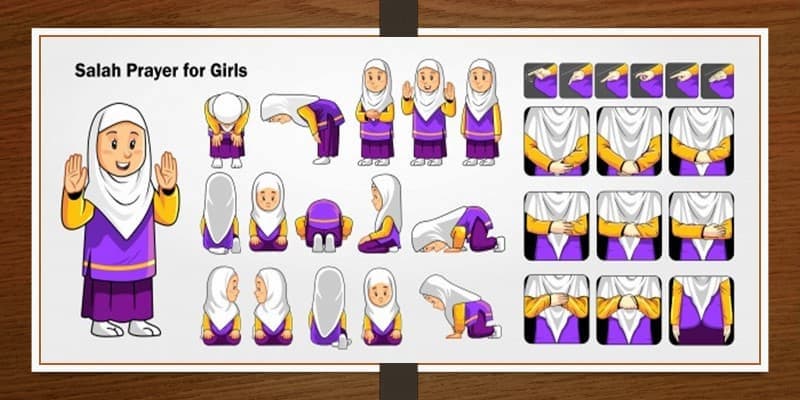Introduction to As-Salah in the book of My salah: Virtues of As-Salah ,Names andTimes of As-Salah Adhan-The call for As-Salah ,Purify yourself ,How to perform Wudu? (Step-by Step)How to perform Ghusl? (Step-by Step) How to perform Tayammum? (Step-by-Step). Compulsory and Sunnah Prayers .In this Article We will learn about How to Perform Salah (Namaz)? Learn Islam.How to perform method of Namaz (Preayers)? (Step-by-Step),As-salah in Congregation and Short Surah of Qur’an Here I did attached Four books of Namaz (Prayer) : First, My Prayer(The 2nd pillar of Islam) What do we learn?
Introduction to As-Salah (method of Namaz (Preayers):
Brief Content
- Purify yourself
- Virtues of As-Salah (Namaz)
- Adhan-The call for As-Salah (Namaz
- Names and Times of As-Salah (Namaz)
- How to perform Wudu? (Step-by-Step)
- How to perform Ghusl? (Step-by-Step)
- How to perform Tayammum? (Step-by-Step)
- Compulsory and Sunnah Prayers (Namaz)
- How to perform Salah? (Step-by-Step)
- As-salah in Congregation (Namaz)
- Short Surah of Qur’anThe Writer of the Book Prayer: Shaykh Mohammad Abdur Raoof
In the second book of Salah (complete method of salah).What do we learn?
- How to perform Obligation to offer Prayer
- How to perform Importance of Prayer
- How to perform The Superity of Prayer
- How to perform Anger and Persecutions
- How to perform Method to say Prayer to Men
- How to perform Method to say Prayer to Women
- How to perform 40 Hadith the Messenger of Allah. The Writer of the Book Prayer: Online eQuran study
In the Third book of Salah, What do we learn? How to Perform Salah (Namaz)? Learn Islam
- Emaan-e- Mufassal and Emaan-e-Mujmal
- How to perform Six Kalmah
- How to perform Dua to Exit the Mosque
- How to perform Dua to Enter The Mosque
- How to perform Aazan
- How to perform Complete Namaz in Arabic and Prayer after saying the Prayers The Writer of the Book Mufti Abdul Rauaf
In the Forth book of Salah, In this book (How to Perform Salah (Namaz)? Learn Islam) there are: Two chapters, Abulation detial, In the second chapter, Types of Prayers and Number of Rakat
Namaz Rakats details
Amounts of rakats for each time are:
Fajr Namaz = There are Four Rakat 2+2=4 (First two rakat Sunnat Mokadda then two rakat Fard) ;
Zuhr Namz =First four rakat Sunnat Mokadda then four rakat Fard then two rakat sunnat Mokadda 4+4+2+2=12; (two rakat nafils at the end are optional)
Asr Namaz =First four rakat sunnat ghair mokadda then Four rakat Fard 4+4=8; (Four Rakat Sunnar is optional)
Maghrib Namaz = First three rakat Fard then two rakat Sunnat Mokadda 3+2+2; (Two nafils after sunnat are optional)
Isha Namaz = First Four rakat Fard then two rakat sunnat mokkada then three rakats Wajib 4+4+2+2+3+2=17; (four rakat sunnat e ghair mokadda before farz, two nafil before and two after Wajib are optional)
THE Messenger of Allah said that Namaz is the key of success. Namaz has many benefits. The holy prophet said that method of Namaz (Preayers) is the difference between muslims and kafir. When we will Stand for salah then we will erect facing the Qiblaĥ in the state of Wuḍū with a distance of four fingers between feet. Now raise your hands and touch the ear-lobes. Fingers should neither be too close together nor too wide apart; instead, they should remain in a normal position, palms facing the Qiblaĥ. Eyesight should be focused at the place of Sajdaĥ.
Now make a firm intention (in your heart) of the Ṣalāĥ that you are about to offer. To say it verbally is better . If you are in a Jamā’at, add the words “following this Imām.” Now, utter Takbīr-e-Taḥrīmaĥ lowering your hands and fold them below navel with right palm on the back of left wrist joint, three middle fingers straight on the back of left forearm and thumb and small finger catching the wrist both side . Now recite Šanā like this:
Glory is to You Yā Allāĥ ! I praise You, Blessed is Your name, Your greatness is lofty and none is worthy of worship except You. Then recite the Ta’aw-wuż:I seek refuge of Allah from the accursed satan. Then recite the Tasmiyaĥ(bismillah): Commencing with the name of Allah, Most Merciful.
Then recite the whole of Sūraĥ Fātiḥaĥ: All praises due to Allah, Sustainer of the entire creation. The Most Compassionate, Most Merciful. Owner of the Day of compensation. May we worship only Allah , and seek help from only Allah . Enable us to walk the straight path.
The path of those people whom You have blessing upon them . Not of those who have been subjected to wrath, and not of those who went astray.After you finish Sūraĥ Fātiḥaĥ, utter (Āmīn) in low volume and then recite either three short Ayaĥs or one long Āyaĥ that is equivalent to three short Ayaĥs or any Sūraĥ such as Sūraĥ Ikhlāṣ. Commencing with the name of Allah, Most Compassionate, Most Merciful. Declare He is Allah, He is one. Allah is absolute self-reliant. He has no progeny, nor is He born from anyone. And there is none equal to Him.
Now bow down for Rukū’ uttering SUBHANA RABI YAL AZEEM .Hold knees firmly with both palms and keep fingers spread out. The back should be straight and head should also be in the straightness of the back (not lower or higher than the back); in Rukū’, focus eyesight at feet. Recite at least three times in Rukū’. Then utter the Tasmī’ SUBHANA RABI YAL AZEEM and stand erect; the standing after Rukū’ is called Qawmaĥ.
If you are a ( O Allah ! O our Rab All praises are for You only.)Munfarid then utter Then, go down for Sajdaĥ uttering placing your knees first on the ground, then hands and then head (nose first and then the forehead) in between your hands. Make it sure that your nasal bone (not just the tip of your nose) and your forehead properly rest on the ground; in Sajdaĥ, focus eyesight at nose; keep arms separated from sides, belly from thighs and thighs from shins (but if you are in a Jamā’at then keep arms close to sides).
The tips of all ten toes should be towards Qiblaĥ with their soles flattened with the ground. Your palms should be flat on the ground with fingers facing Qiblaĥ, but do not keep the forearms touching the ground. Now recite at least three times; then lift your head (forehead first then nose), then hands and sit up straight; keep your right foot upright with its toes facing Qiblaĥ; lay your left foot flat and sit on it; place your palms on your thighs close to your knees with your fingers facing Qiblaĥ and their tips by the knees. Sitting in between two Sujūd is called Jalsaĥ. One must stay in this position for at least the amount of time in which SUBHANALLAH can once be uttered to utter (Yā Allāĥ forgive me.”)in Jalsaĥ is Mustaḥab.
Now, perform the second Sajdaĥ uttering SUBHANA RABI YAL AALAH in the same way as the first one. Now, raise the head first; then stand up with the support of your toes placing your hands on your knees. Do not lean hands unnecessarily on the ground while standing up. You have now completed one Rak’at.
In the second Rak’at, start with BISMILLAH and then recite Sūrae-Fātiḥaĥ and another Sūraĥ, then do the Rukū’ and Sujūd as you did in the first Rak’at. After completing the second Sajdaĥ (of the second Rak’at) sit up straight with your right foot upright and your left foot flat. To sit after the second Sajdaĥ and Rak’at is called Qa’daĥ. Recite Tashaĥĥud in Qa’daĥ:
All types of worship i.e. oral, physical and monetary are for Allāĥ Salutation be upon you Yā Nabī and the mercy and blessings of Allāĥ . Salutation be upon us and the pious men of Allāĥ .I testify that there is none worthy of worship except Allāĥ and I testify that Muḥammad is His (distinguished) Servant and Rasūl When you are about to utter the word LAA in Tashaĥĥud, form a circle with the middle finger and thumb of your right hand and put the tips of your ring-finger and the pinkie at palm; as soon as you begin to utter the word “LAA” (immediately after raise your index finger without waving it side to side.
When you reach put it down and straighten your all fingers out instantly. If you are offering more than two Rak’āt, stand up erect and saying .If it is Farḍ Ṣalāĥ, recite only and Sura-e-Fātiḥaĥ in the third and fourth Rak’āt, an additional Sūraĥ is not needed. The rest of the acts must be performed in the same way as before.
However, you shall be added surah after Sūraĥ Fātiḥaĥ in the third and fourth Rak’āt . Once you have offered all four Rak’āt, sit in Qa’daĥ-e-Ākhīraĥ, and then you will recite Tashaĥĥud and the Durūd-e-Ibrāĥīm
O Allāĥ send Durūd on (our Master) Muḥammad PBUH and on his descendents as You sent Durūd on (our Master) Ibrāĥīm and his descendents. Indeed you alone are praise worthy and Glorious.(O Allāĥ shower Your blessings on (our Master) Muḥammad PBUH and his descendents as You showered blessings on (our Master) Ibrāĥīm and his descendents. Indeed You are praise worthy and Glorious.
Then recite any Du’ā (Ya Allah ) Grant us best in this world and best in the next world and save us from the torment of hell-fire. Then, to finish the Ṣalāĥ, first turn face towards right shoulder saying and then towards left shoulder saying the same words. Now your Ṣalāĥ has completed. (Baĥār-e-Sharī’at, pp. 504-506, vol. 1, etc.) HERE I, did attatch 3 books of method of Namaz (Preayers)
In the first the book of Salah .In this book writer did brief with pictures and with Graf .This is the best book method of Namaz (Preayers) (My Salah)
Related Topics: If you really enjoy this article, then there are some more informative posts for you!
Arabic Books , Lisan al-‘Arab , Best Holy Books of Islam, Learn Arabic, Introduction to Surah Yaseen , Surah Al-Isra, Surah Yaseen Transliteration , Al Quran Karim 16 Lines , Quran word by word , Root Words of Quran, Importance and Benefits of Ayatul kursi , Second Surah Al-Baqarah, Quran Dictionary PDF Free Download .
Our Android Apps
About CEO Al-Asad Online
Hafiz Abdul Hameed
Master In Islamic Studies
(Tajweed, Waqf)
Web Developer/Administrator
Web Content Writer
Blogger, SEO Expert
Graphic Designer
WhatsApp: +92 301736










